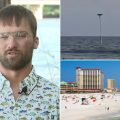
The recent tragic collision of a Mexican navy tall ship with the Brooklyn Bridge serves as a stark reminder of a recurring hazard: ships hitting the iconic structure. This incident, sadly resulting in fatalities, highlights a problem that has plagued the bridge for almost 150 years.
Even before its completion in the late 19th century, the bridge’s wires were struck by a U.S. Navy ship’s topmast. Over the years, numerous vessels have grazed or collided with the bridge, but Saturday’s accident marks the first time crew members have lost their lives in such an incident. Two Mexican naval cadets perished, and others were injured when the training ship Cuauhtémoc’s masts crashed into the bridge during a public display. Dominique Jean-Louis, chief historian at the Center for Brooklyn History, emphasizes that this appears to be the only fatal collision in the bridge’s history.
The Brooklyn Bridge, opened in 1883, spans the East River, connecting Brooklyn and Manhattan. Its underside’s highest point averages 135 feet above the water, a height which can fluctuate with the tides. Even during construction, the bridge’s height became a legal battleground. A warehouse owner sued, arguing that the bridge obstructed tall-masted ships. The case eventually reached the Supreme Court, which dismissed the lawsuit, deciding the bridge did not unduly restrict navigation. Ironically, even before this ruling, at least one ship, the USS Minnesota, had already struck the bridge’s wires during construction, though without injuries.
The transition from sail to steam ships significantly reduced the need for high masts, but mast strikes persisted. Incidents continued into the 20th century, with at least two reported in the 1920s, including one involving the USS Seattle. A striking account from 1941 details the SS Nyassa, carrying refugees, encountering the bridge due to a miscalculation of the tide, resulting in a bent mast. Even as ships grew taller and wider, the need for mast-like structures for observation and communication remained.
The Brooklyn Navy Yard, located nearby, produced increasingly large ships, including aircraft carriers that could only just clear the bridge’s height. A photograph from 1961 shows the USS Constellation, with its specially designed folding mast, navigating beneath the bridge. More recently, several minor collisions have been reported, involving cranes and barges, causing damage but not serious injury.
It’s important to note that the bridge’s history is filled with tragedy beyond ship collisions. Construction resulted in over 20 deaths and countless injuries. Furthermore, a stampede shortly after the bridge’s opening caused 12 fatalities. The recent accident, therefore, underscores a long and complex history of both maritime and construction-related hazards associated with this iconic landmark.










